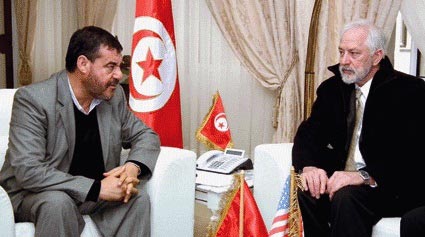Collaboration is key for the WYC
A collaboration between 31 partner organizations, with 83 expert scientists, the Wheat Yield Consortium (WYC) aims to increase wheat yield potential 50% by 2030. This unprecedented project was established by CIMMYT in 2009, and during 13-15 March 2012, 69 stakeholders from 11 countries met at the Campo Experimental Norman E. Borlaug (CENEB) near Ciudad Obregon, Sonora, Mexico, for the 2nd International Workshop of the WYC. The aim of the meeting was to present the progress made so far and how to raise the funding required to reach the target.
In order to speed the delivery of new wheat genotypes to farmers, the WYC strategically integrates three scientific themes into a synergistic approach for increasing wheat yields: Theme 1 looks to increase total plant biomass by improving photosynthetic capacity whilst the research in Theme 2 simultaneously optimizes partitioning of assimilates to yield in diverse environments whilst increasing the strength of the plant to avoid the risk of lodging. These themes feed into Theme 3, which is focused on incorporating improved yield potential traits into elite breeding lines adapted to wheat agro-ecosystems worldwide.
On the first day, CIMMYT Wheat Physiologist Matthew Reynolds presented an overview of the science and Steve Visscher from the UK’s Biotechnology and Biological Science Research Council (BBSRC) addressed the criteria by which such an ambitious project will be reviewed by the science and development assistance community. Director of CIMMYT’s Global Wheat Program, Hans Braun, then addressed scenarios by which the WYC might become fully funded. The WYC currently operates mainly with Mexican Government funds (through the MasAgro initiative), while the Chinese Academy of Agricultural Sciences (CAAS) and other WYC affiliated organizations, including CIMMYT, make substantial in-kind contributions. One of the main focuses of the workshop was to finalize the WYC Business Plan, which will shortly be submitted for peer review, before being presented to potential donors in order to attract the first installment of funding in what is expected to be a 20 year endeavor. “The meeting was a lot of hard work for everybody but team spirit was excellent and we are all optimistic about the WYC,” said Reynolds.
Participants also had the opportunity to visit the Mexican Phenotyping Platform (MEXPLAT), which is playing a vital role in many of the sub-projects. Whilst there, they had the opportunity to witness the launch of CIMMYT’s new blimp. MEXPLAT is based at CENEB and provides laboratory and experimental field facilities, as well as the provision and/or distribution of shared germplasm panels (including the CIMCOG set, which has been used in much of the WYC research conducted so far and is currently being grown at 20 sites worldwide).
On the final day, Undersecretary of the Mexican Ministry of Agriculture, Livestock, Rural Development, Fisheries and Food (SAGARPA), Mariano Ruiz-Funes, took time to visit the workshop and reiterate the support of the Mexican Government. “Mexico is fully committed with this project,” he said, before expressing how the Mexican Government plans to use their presidency of the G20 this year to promote agricultural research.

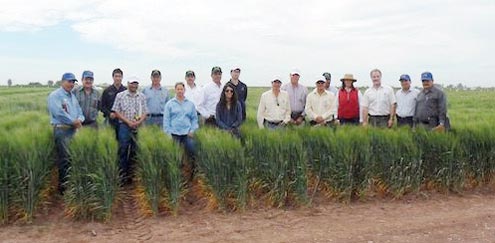
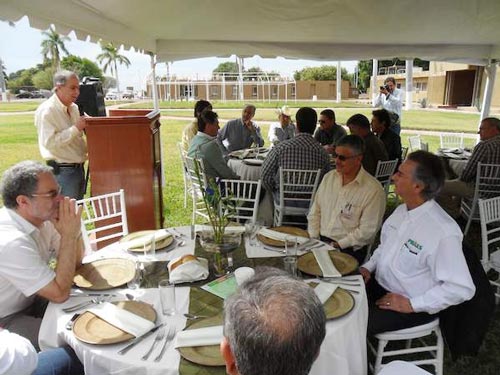 During the visit, Govaerts demonstrated the MasAgro machinery platform, and explained the importance of Mexico being able to manufacture crop machinery and implements that can be used in the different agro-ecological zones of the country. Govaerts stressed that these technology transfer processes must impact farmers, technicians, researchers, and companies which develop this type of machinery in the different regions.
During the visit, Govaerts demonstrated the MasAgro machinery platform, and explained the importance of Mexico being able to manufacture crop machinery and implements that can be used in the different agro-ecological zones of the country. Govaerts stressed that these technology transfer processes must impact farmers, technicians, researchers, and companies which develop this type of machinery in the different regions.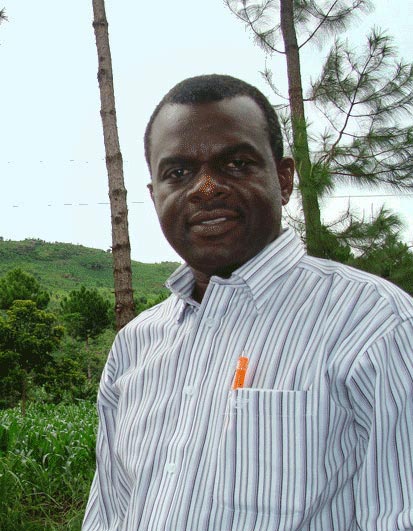 Paul Mapfumo, member of the global conservation agriculture program and coordinator of SOFECSA—the Soil Fertility Consortium for Southern Africa—has been awarded a full professorship at the University of Zimbabwe in Harare as of March 2012, with the details of his continued relationship with CIMMYT to be worked out. Having opened its doors in 1952, the University is the oldest and largest university in Zimbabwe and has 10 faculties, including agriculture, as well as specialist research centers. “The SOFECSA work in CIMMYT—so much appreciated by communities and partners in Zimbabwe—was a major driver for this achievement,” said Mapfumo. “So thanks to CIMMYT and all our great partners.” SOFECSA is an inter-institutional and interdisciplinary consortium to undertake field- level adaptive research and development activities that enhance the impacts of integrated soil fertility management technologies on food security and farm incomes in Southern Africa and beyond.
Paul Mapfumo, member of the global conservation agriculture program and coordinator of SOFECSA—the Soil Fertility Consortium for Southern Africa—has been awarded a full professorship at the University of Zimbabwe in Harare as of March 2012, with the details of his continued relationship with CIMMYT to be worked out. Having opened its doors in 1952, the University is the oldest and largest university in Zimbabwe and has 10 faculties, including agriculture, as well as specialist research centers. “The SOFECSA work in CIMMYT—so much appreciated by communities and partners in Zimbabwe—was a major driver for this achievement,” said Mapfumo. “So thanks to CIMMYT and all our great partners.” SOFECSA is an inter-institutional and interdisciplinary consortium to undertake field- level adaptive research and development activities that enhance the impacts of integrated soil fertility management technologies on food security and farm incomes in Southern Africa and beyond.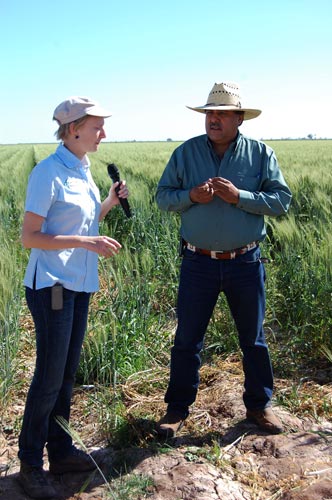
 A training course was held at the Agricultural Research Trust (ART), in Harare, Zimbabwe during 12-15 March 2012. Organized by CIMMYT-Zimbabwe, the course aimed to improve the skills and knowledge of maize technicians regarding implementing on-station and on-farm trials, seed production, and the use of secondary traits in selecting superior genotypes under low N and drought trials.
A training course was held at the Agricultural Research Trust (ART), in Harare, Zimbabwe during 12-15 March 2012. Organized by CIMMYT-Zimbabwe, the course aimed to improve the skills and knowledge of maize technicians regarding implementing on-station and on-farm trials, seed production, and the use of secondary traits in selecting superior genotypes under low N and drought trials.
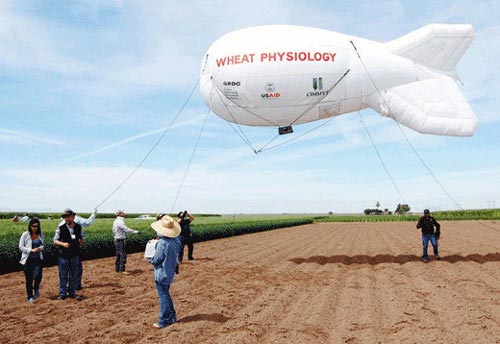 Visitors to the Centro Experimental de Norman E. Borlaug (CENEB) station, near Ciudad Obregon, Sonora, were lucky enough to witness the launch of CIMMYT’s first blimp on 13 March 2012. Made possible through generous support from the Sustainable Modernization of Traditional Agriculture (MasAgro) project, the 8-meter helium-filled balloon underpins the airborne remote-sensing “platform” of the CIMMYT wheat physiology group. It will help analyze the physiological properties of thousands of wheat lines being tested as part of the Mexican phenotyping platform (MEXPLAT).
Visitors to the Centro Experimental de Norman E. Borlaug (CENEB) station, near Ciudad Obregon, Sonora, were lucky enough to witness the launch of CIMMYT’s first blimp on 13 March 2012. Made possible through generous support from the Sustainable Modernization of Traditional Agriculture (MasAgro) project, the 8-meter helium-filled balloon underpins the airborne remote-sensing “platform” of the CIMMYT wheat physiology group. It will help analyze the physiological properties of thousands of wheat lines being tested as part of the Mexican phenotyping platform (MEXPLAT).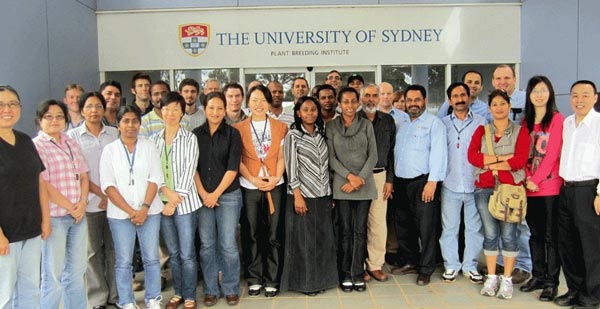
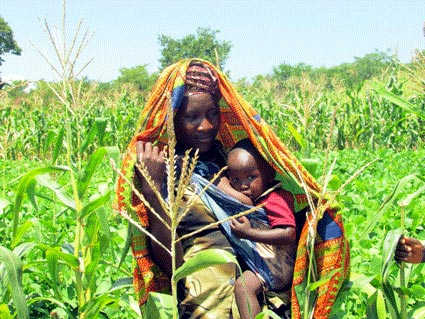 In February 2012 several CIMMYT staff working in
In February 2012 several CIMMYT staff working in 